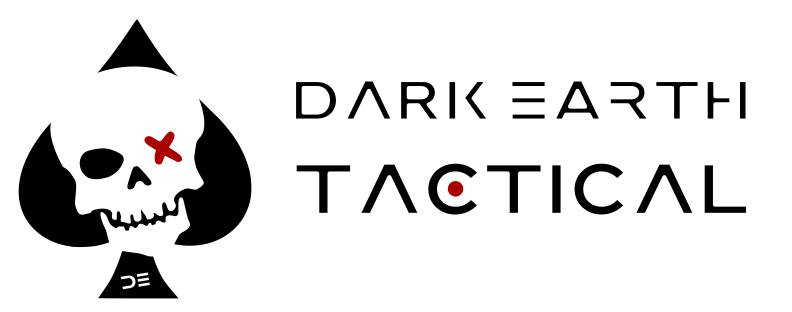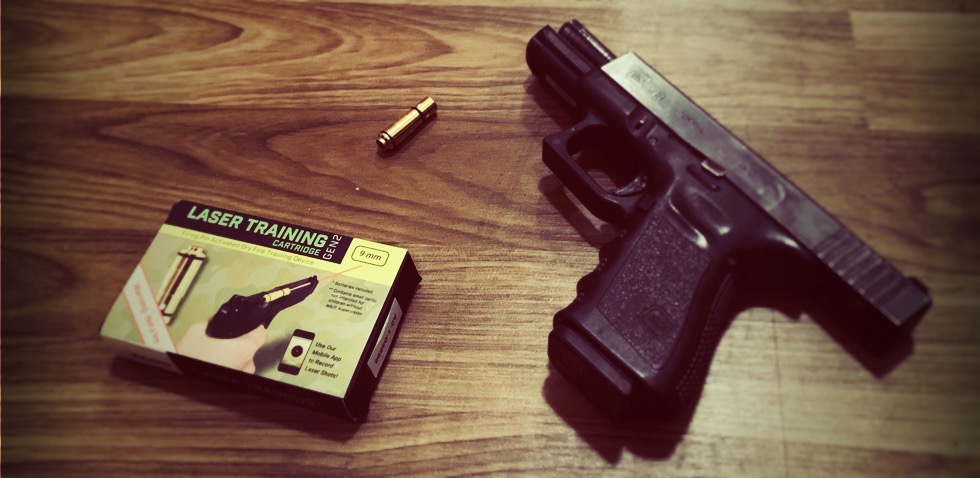Dry fire training is the act of simulating firing a pistol, rifle or shotgun without live ammunition, giving you the ability to improve your shooting skills in the comfort of your own home. I personally spend anywhere from 2 to 7 hours dry fire training per week, and have first-hand proof that it increases speed and proficiency in weapons handling, while preventing skill-fade when I am unable to hit the range. So why is dry fire training so effective, and can it cause damage to your firearm?
Dry fire training is effective because it allows you to develop proper habits and weapons handling skills at home, without any cost involved. This in turn allows for a far greater summation of accomplished training. It is also completely harmless and doesn’t damage the mechanical parts of modern centerfire guns.
Bad habits are so easy to make, yet so hard to break, and while dry firing is the most cost effective and time-saving way to develop proper habits, it is super important that it is done correctly from the start.
How Effective is Dry Fire Training?
Opponents of dry firing will argue that this form of training doesn’t actually simulate live firing closely enough to be productive. This couldn’t be further from the truth.
There is tons of evidence demonstrating the positive effects of dry fire training, and it is a well known fact that the only way to get good at something is to practice. By practicing drills and techniques through dry fire training, you are developing muscle memory in all areas of weapons handling; on par with live fire training. The only areas that remain and need to be further rehearsed through live fire training are recoil management, sight reacquisition, and dealing with audible sound.
Be sure to supplement dry fire training with live firing wherever possible. This will ensure you have experience with the force, sound and feel of firing a live round.
Springfield Armory Blog: A Beginners Guide to Dry Firing
It is even possible to simulate stoppage drills through dry fire training. For more information on stoppage drills you can read the following article: Common Firearm Malfunctions [and How to Clear Them].
Developing Muscle Memory Through Dry Firing
Simply put, muscle memory can be defined as building habits. When building muscle memory under combat or tactical training scenarios, it is of the utmost importance that these habits are proper habits. We need to ensure that we are building proper habits by using the correct techniques and fundamentals, as bad habits are extremely difficult to break.
Muscle memory is a form of procedural memory that involves consolidating a specific motor task into memory through repetition, which has been used synonymously with motor learning.
Wikipedia
Building proper habits is achieved by repetition of correct methods and techniques; repeating the same training drill over and over, thousands of times. This will result in muscle memory development.
Once muscle memory has been achieved, you would have succeeded in building a conditioned response that will allow the subconscious mind to automatically take over and respond to high-stress or high-speed scenarios. This allows you to focus on other things such as threat level, follow-through, escape routes, use of cover, communications, and so on – when a life threatening scenario is underway.
PERFECT PRACTICE MAKES PERFECT PERFORMANCE
Just as research has proven that athletes start losing muscle after only three weeks of inactivity, combat skill-fade also begins to develop after only 21-days of inaction. It is therefore highly recommended to keep muscle memory ticking over once it has been achieved. This means training often and regularly, aiming to prevent a training lapse within a 3-week period.
Does Dry Fire Training Damage Your Firearm?
Most of you have probably heard that pulling (better described as squeezing) the trigger with an empty chamber is harmful to your firearm, and that it can break or damage the firing pin/ striker. While there is some truth to this statement amongst rimfire calibers, the modern centerfire gun is able to withstand thousands of dry fire cycles before showing any signs of wear and tear.
- There are some (although very few) older cernterfire guns that may not handle dry firing very well. Due to the age and rarity of these older firearms and their spare parts, dry firing is not recommended.
- When it comes to rimfire pistols and rifles, the general rule of thumb is to avoid dry firing unless you are certain that the rifle or pistol can handle dry firing without weakening or damaging the firing pin or chamber. However, many modern rimfire guns are manufactured with a firing pin stop. This prevents the firing pin from hitting the chamber wall if there is no cartridge in the chamber. In this case, dry firing is acceptable.
The solution to safe dry fire training during uncertainty is to use a snap cap.
Using Snap Caps to Safeguard Your Firing Pin [or Striker]
A snap cap can be described as an inert training cartridge that is shaped like a real firearm cartridge, but contains no real primer, propellant or projectile. They differ from dummy rounds in that they are specifically designed to be used during dry fire training, while preventing stress and impact damage to a firing pin, striker, or chamber that may otherwise be harmed during the dry fire process.
We have already discussed that some rimfire and a small number of older centerfire firearms should not be dry fired on an empty chamber, as this can lead to weakening or breakage of the firing pin/ striker and increased wear to other components in those firearms. Under these circumstances, or if you wish to increase the authenticity of your training, the snap cap may be an excellent tool to do the job.
Dry Fire Laser Training
With the evolution of modern technology, there now exists a few reputable manufacturers of laser training cartridges that fit common calibers, and are designed to project a laser beam onto your target when the trigger is squeezed. Not only do they project a laser showing visual representation of your shot placement, but they are also designed to work alongside mobile apps and TV screens to produce realistic sounds and real-time impact markers or groupings on target. The technology is extraordinary.
I have tried and tested the following laser training cartridges, and thoroughly enjoyed them (aside from the mechanical issues that I get from time to time).
- G-Sight 9mm, $35
- LaserLyte 9mm, $95
I also occasionally use LaserHIT, a mobile app which produces visual shot placement and audible sound feedback when used with a laser training cartridge. The app is free (with in-app purchases) and is well worth a try.
Note: laser training cartridges are known to be troublesome. Sometimes you get lucky and may find the product to be flawless, while on other occasions your laser training tool may have a short-lived lifespan.
Using Human Silhouette Targets to Build a Conditioned Response
The fight-or-flight response is a physiological reaction that occurs in response to a perceived harmful event, attack, or threat to survival. Most shooters who train for home defence understand the importance of proper training and muscle memory development in order to instinctively select a fight over flight response when presented with a threat.
Believe it or not, training targetry plays a large role in developing conditioned reflexes. A conditioned reflex is defined as an automatic response established by training to an ordinarily neutral stimulus. In other words, training to build an automatically triggered response.
B.F. Skinner – who was one of the most influential of American behavioural psychologists – proved through comprehensive battlefield testing that a human being is far more capable of taking a life (in our case this would be through self defence) when training using human silhouette targets that depict an enemy combatant or threat to life.
It is therefore highly recommended to include multiple human silhouette targets in your dry fire training in order to develop this conditioned response. When dry fire training on these targets, also pay particular attention to shot placement, aiming to achieve rapid and instant incapacitating shots where possible.

- Bullseye Targets & Small Aiming Markers – these are ideal for developing proper trigger control and sight alignment. Pay particular attention to the firearms foresight or reticle while squeeing the trigger, until you experience no movement when the firing pin or striker is released.
- Human Silhouette Targets – trains your conditioned reflexes for defensive shooting, while allowing you to develop muscle memory in shot placement.
- Human Silhouette Target Posing a Threat – trains your conditioned reflexes for defensive shooting, while allowing you to develop muscle memory in shot placement, threat response and speed. Also makes you think about use of cover and personal protective gear.
Safety, Safety, Safety
I know that we always harp on about safety, but that is because it is vitally important.
When dry firing, correct practice is to clear any firearms being used and then store live ammunition in a separate (ideally lockable) room. Always confirm that you are completely clear of live ammo before training begins, and if you are training with a partner, then clear one another before you start.
Even though no live rounds are being used, you still need to follow the 4 rules of gun safety.
Summary
While dry firing is often overlooked either due to laziness or ignorance, I highly recommend getting into a dry fire training routine. Once a routine has been established and skills start to progress, it becomes a thoroughly enjoyable method of training at home.
If you are a beginner, aim to master your trigger squeeze & sight alignment before speed. Speed will develop naturally in line with everything else.
And finally, always remember to train how you fight, because you’ll fight how you train.
If you enjoyed reading this post and found it useful, don’t keep it to yourself; help us spread the word – select a social share button below. And should you wish to share your thoughts or ask a question, scroll down and leave us a comment 🙂


8 thoughts on “Dry Fire Training: Improving Your Shooting At Home”
Hello, I would like to know about the availability of the possibility of placing information on our website. I am a representative of the “SHOOTING-SOFT.COM” company. Our shooting simulator software helps people to become more self-confident and get the initial shooting and training professionally, even at home. As an example, you can place a comment on your blog with a link to our website.
I’ve been looking into dry fire practice lasers. Didn’t know about the laserhit, I’ve also seen Mantis in a few articles and forums, know anything about that?